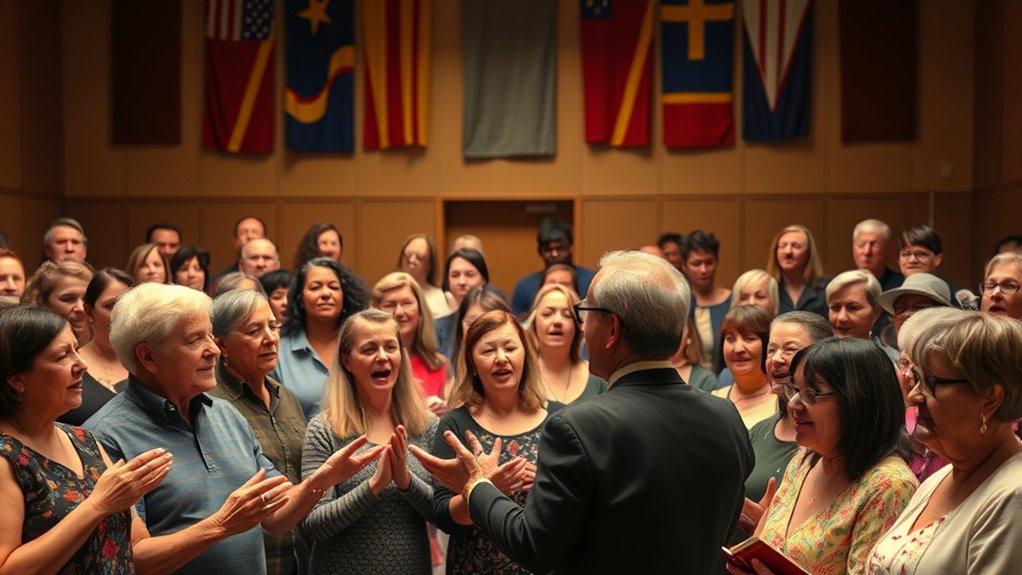Community choirs act as social glue by bringing people together through collective singing, fostering cultural pride, emotional well-being, and social bonds. They evolve from simple beginnings rooted in tradition to vibrant platforms for diversity and inclusion, using technology to grow. Participating can boost confidence, reduce stress, and strengthen community identity. To discover how these musical gatherings continue to shape communities and support individual resilience, explore more about their inspiring journey and impact.
Key Takeaways
- Community choirs foster social cohesion by uniting diverse individuals through collective singing and shared musical experiences.
- They strengthen community identity by performing songs rooted in local history, dialects, and cultural traditions.
- Collective singing in choirs builds trust, camaraderie, and emotional bonds among participants.
- Choir activities promote inclusion, cultural exchange, and intergenerational dialogue within communities.
- Modern technology enhances outreach and engagement, expanding the social impact of community singing.
The History and Evolution of Community Choirs

Have you ever wondered how community choirs began and how they’ve changed over time? Their roots stretch back centuries, rooted in communal gatherings for worship, celebration, and social connection. Historically, these choirs started as local groups singing sacred or folk music, often led by community leaders or clergy. Over time, their purpose broadened, reflecting the musical evolution from simple melodies to more complex arrangements. As societies modernized, community choirs adapted, incorporating diverse musical styles and expanding participation beyond traditional boundaries. Today, they serve not only as artistic outlets but also as essential social platforms. This journey from humble beginnings to vibrant, inclusive groups highlights how community choirs have continuously evolved, blending historical traditions with contemporary musical influences to foster connection and shared identity. Utilizing design thinking principles, these ensembles have innovated their approaches to community engagement and artistic expression, ensuring their relevance in the modern era. Furthermore, the growth of cultural diversity within these choirs has played a significant role in shaping their evolution and broadening their appeal. An understanding of musical tradition underscores how these groups maintain a connection to their cultural roots while embracing innovation. Additionally, the incorporation of modern technology has enabled community choirs to reach wider audiences and enhance their collaborative efforts. Moreover, understanding the environmental impacts of traditional practices helps ensure that these groups adopt more sustainable methods for their future growth.
Building Connections Through Collective Singing
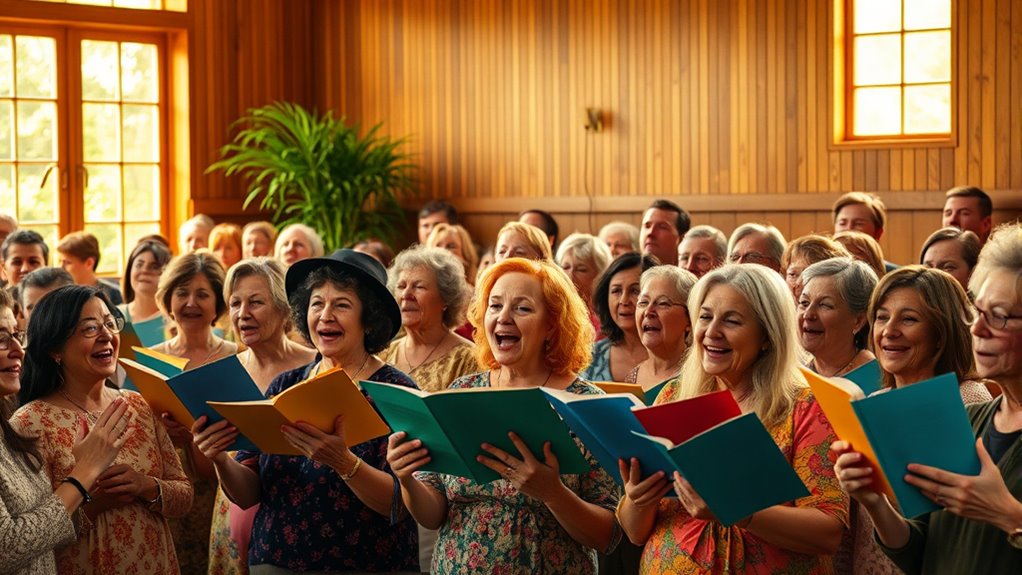
Collective singing fosters a unique sense of connection among participants, transforming individual voices into a unified sound. As you learn vocal techniques together, your voices blend seamlessly, creating harmony that boosts audience engagement. When everyone sings in sync, it feels like you’re part of something bigger. Imagine the energy in the room:
| Voices Rising | Shared Rhythm | Audience Reacts |
|---|---|---|
| Personal tone | Unified beat | Cheers & applause |
| Unique pitch | Collective strength | Smiles spread |
| Vocal flow | Emotional bond | Applause swells |
This shared experience builds trust and camaraderie. Through collective singing, you break down barriers, fostering a sense of community rooted in the power of your collective voice. Just as shared data enhances online experiences, collective singing harnesses the power of synchronization to create a profound emotional connection among participants. Incorporating body awareness techniques can further deepen the connection to your own voice and the group dynamic. Recognizing the importance of group coordination helps participants synchronize more effectively and enhances the overall harmony. Additionally, understanding the role of vocal blending can improve the cohesiveness of the group’s sound, making the collective performance more compelling.
Mental and Emotional Benefits of Participating in Choirs
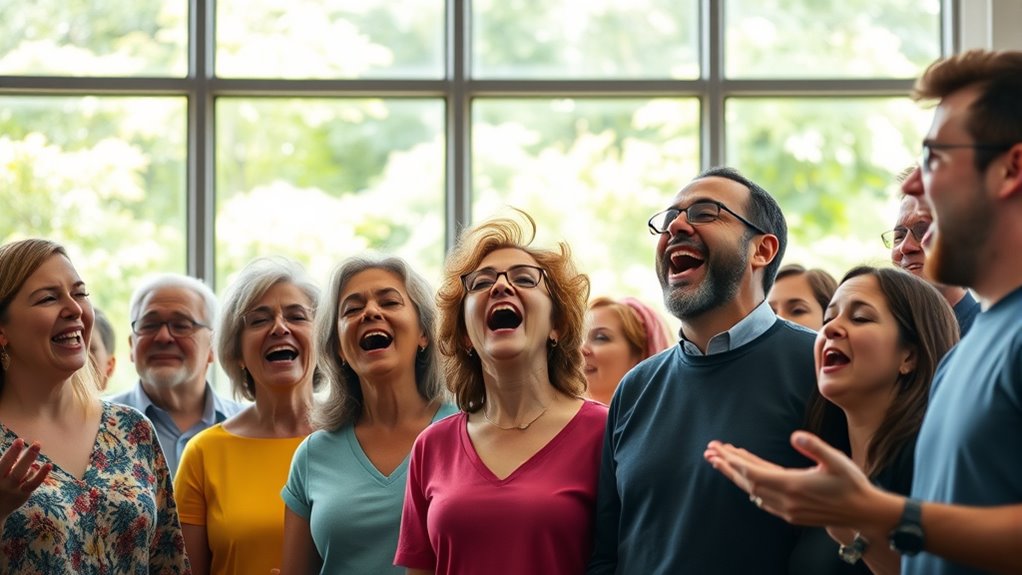
Singing in a choir can help you relax and reduce stress after a busy day. It also boosts your confidence and brings a sense of joy that lifts your mood. These emotional benefits make choir participation a powerful way to support your mental well-being. Additionally, engaging in group activities like singing can foster a sense of community and belonging. Understanding the psychological impacts of group activities like singing can deepen your appreciation for their role in mental health. Participating in such social activities can also promote mental clarity, making it easier to focus and process emotions effectively. Exploring different knitting patterns for sweaters can further enhance your sense of accomplishment and mindfulness.
Stress Reduction Through Song
Participating in a community choir can considerably reduce stress by providing a sense of connection and purpose. As you sing, you engage in vocal techniques that help control breathing and release tension, promoting relaxation. Focusing on your voice and pitch shifts your attention away from stressful thoughts. Additionally, the act of engaging in mindfulness through focused singing and active listening encourages present-moment awareness, lowering cortisol levels and calming your mind. This focused attention can also lead to improved concentration and mental clarity outside of singing. Audience engagement, even in a small group, fosters feelings of belonging and shared achievement, boosting your emotional well-being. Singing with others creates a supportive environment where you can express emotions safely, which further alleviates stress. Furthermore, understanding how sound quality impacts your listening experience can enhance the overall enjoyment and emotional benefits of choir participation. Good sound quality not only enhances musical appreciation but also amplifies the emotional impact of singing together. Overall, the combination of vocal techniques and social interaction makes singing an effective way to unwind and improve mental health.
Boosting Self-Esteem and Joy
Joining a community choir can substantially boost your self-esteem and bring a sense of joy. As you learn and refine your vocal techniques, you’ll gain confidence in your singing abilities, which translates into a positive self-image. Engaging with diverse repertoire selection challenges you to explore new genres and styles, making each rehearsal a rewarding experience. Successfully mastering these pieces provides a sense of accomplishment that elevates your mood. Singing with others creates a shared sense of achievement and belonging, reinforcing your value and worth. The supportive environment of a choir encourages you to step outside your comfort zone, helping you embrace your voice. Regular practice and participation can also contribute to improved self-confidence through consistent effort and achievement. Participating in group singing has been shown to boost emotional well-being, fostering feelings of happiness and connection. Over time, this combination of skill-building and camaraderie cultivates genuine joy and enhances your overall self-esteem.
How Community Choirs Foster Diversity and Inclusion

Community choirs serve as essential spaces where diversity and inclusion thrive through intentional outreach and open-door policies. They celebrate cultural representation and embrace language diversity, creating a welcoming environment. Here are four ways they do this:
- Showcasing Various Cultures: They perform songs from different backgrounds, highlighting unique traditions.
- Encouraging Multilingual Participation: Singers are invited to use their native languages, enriching performances.
- Inclusive Recruitment: Choirs actively seek members from diverse communities, breaking down barriers.
- Cultural Events and Collaborations: Partnering with local groups amplifies representation and fosters mutual respect.
The Role of Community Choirs in Strengthening Local Identity
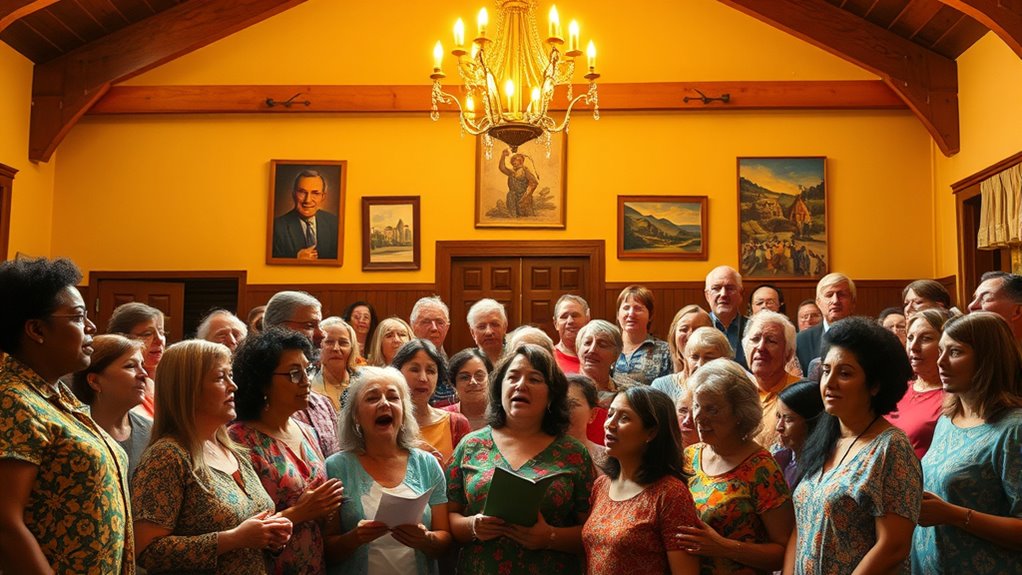
Community choirs play an essential role in strengthening local identity by bringing residents together through shared musical experiences. When you sing with others, you help preserve your community’s cultural heritage and traditions, reinforcing a sense of belonging. These choirs often perform songs rooted in local history or dialects, fostering cultural preservation and pride. As a participant or supporter, you contribute to a collective effort that highlights your community’s unique character. By celebrating local stories through song, community choirs become a source of inspiration and unity. They remind residents of their shared roots, encouraging pride in the place they call home. Ultimately, these choirs serve as a powerful tool for reinforcing local identity and fostering community cohesion.
Challenges and Opportunities in Maintaining Community Choirs
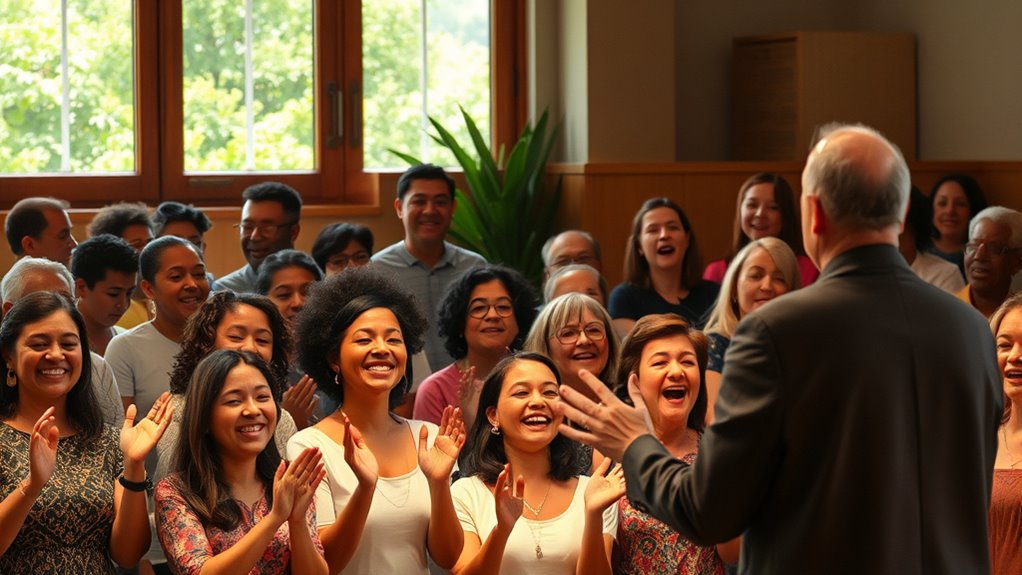
Maintaining community choirs often presents significant challenges, from securing consistent funding to recruiting new members. You might face fundraising challenges that limit resources or struggle to attract volunteers who keep the group active. To overcome these hurdles, consider these opportunities:
- Building partnerships with local businesses for sponsorships
- Hosting fundraising events that engage the community
- Creating volunteer roles that offer meaningful involvement
- Leveraging social media to reach potential members and supporters
Success Stories: Impact of Choirs on Individual and Community Well-Being
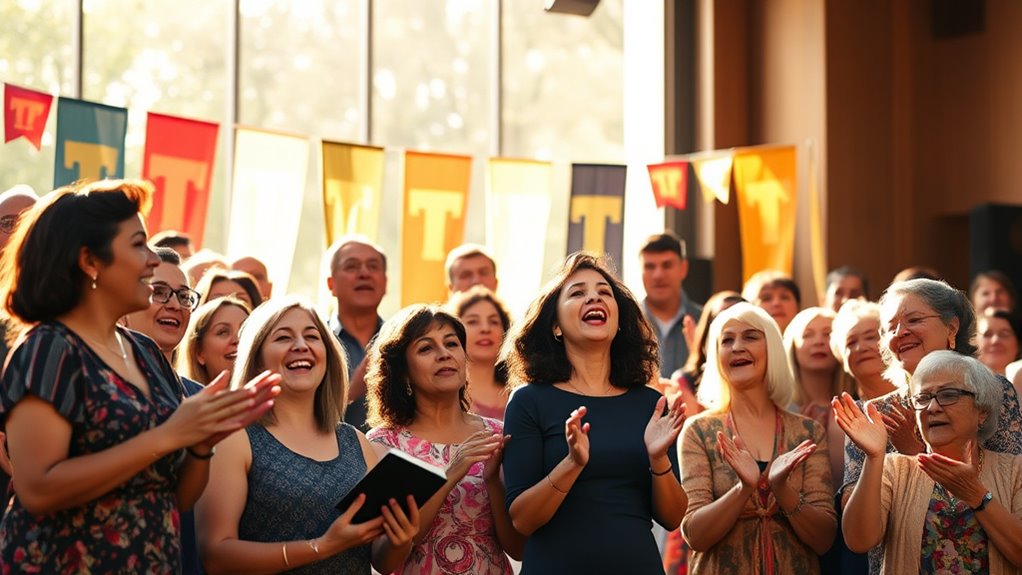
Community choirs often transform lives by building emotional resilience and fostering a sense of belonging. When you sing with others, you not only grow personally but also strengthen the bonds within your community. These success stories highlight how collective music-making can create lasting positive change for individuals and neighborhoods alike.
Enhanced Emotional Resilience
Participating in choir can considerably boost emotional resilience, helping you better cope with life’s challenges. It builds confidence as you master vocal techniques and engage in solo practice, fostering a sense of achievement. Here are four ways choir enhances your emotional strength:
- Reduces stress through the joy of singing and group harmony.
- Boosts self-esteem as you improve your vocal skills and perform confidently.
- Provides emotional release during rehearsals and performances, easing anxiety.
- Fosters community support that encourages resilience during tough times.
Strengthened Community Bonds
When individuals join choir groups, they often experience profound connections that extend beyond singing. These shared experiences foster strengthened community bonds through musical collaboration and cultural exchange. As you sing together, you create a sense of unity that bridges differences and builds trust. Choirs offer a space for diverse voices to blend, promoting understanding and camaraderie among members. The impact reaches beyond the choir room, creating a more cohesive community. The following table highlights key benefits:
| Benefit | Description |
|---|---|
| Musical collaboration | Enhances teamwork and shared achievement |
| Cultural exchange | Fosters appreciation for diverse backgrounds |
| Social cohesion | Builds trust and mutual support |
| Community identity | Strengthens local pride and belonging |
| Emotional connection | Deepens relationships through shared experiences |
Personal Growth Milestones
Joining a choir can be a transformative experience that fosters personal growth and boosts well-being. As you progress, you’ll notice key milestones, such as:
- Mastering vocal techniques that improve your tone, pitch, and breath control.
- Developing confidence through regular rehearsal routines and public performances.
- Overcoming stage fright and embracing your voice within a supportive group.
- Building discipline and resilience as you refine your skills over time.
These milestones not only enhance your singing ability but also contribute to your self-esteem and emotional health. Engaging in consistent rehearsals helps you track progress and stay motivated. Ultimately, your journey in a community choir becomes a powerful catalyst for personal development, enriching both your life and the collective spirit of the group.
Future Perspectives: The Growing Significance of Community Singing
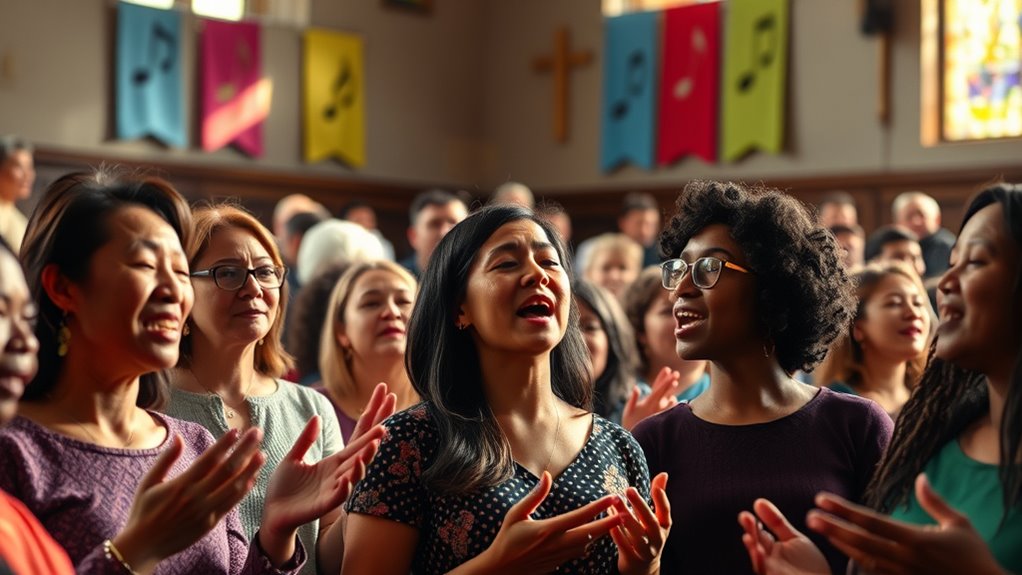
As communities increasingly recognize the mental, social, and cultural benefits of singing together, the importance of community choirs is set to grow even more. You’ll see these groups become essential for cultural preservation, helping to keep traditions alive through song. They’ll also foster intergenerational dialogue, bridging gaps between age groups and sharing stories through music. As more people participate, community singing will strengthen social bonds and create a sense of belonging. Technology may expand access, allowing those who can’t meet in person to still engage. Ultimately, community choirs will continue to serve as a powerful tool for nurturing identity, celebrating diversity, and building resilient, connected communities for the future.
Frequently Asked Questions
How Do Community Choirs Finance Their Activities and Memberships?
You can finance your activities and memberships through various fundraising strategies like concerts, bake sales, and online campaigns. Seeking sponsorship opportunities from local businesses also helps cover costs and provides mutual benefits. By actively engaging your community and building strong partnerships, you guarantee your choir stays financially sustainable, allowing you to focus on making music and fostering connections without the stress of funding concerns.
What Training or Skills Are Required to Join a Community Choir?
Did you know that nearly 60% of community choir members started with no prior singing experience? To join, you typically need basic vocal training and musical literacy, like reading sheet music or understanding pitch. No professional skills are required—just a love for singing and a willingness to learn. Most choirs welcome beginners and often provide training, so your enthusiasm is what matters most.
How Do Community Choirs Adapt During Times of Social Distancing or Online Formats?
During times of social distancing, you can stay connected by participating in virtual rehearsals and online performances. Community choirs adapt by using video conferencing platforms to practice together, share recordings, and perform virtually. This approach keeps members engaged and maintains the sense of community, even from afar. You’ll find that online formats foster creativity and camaraderie, allowing your choir to continue singing and supporting each other despite physical separation.
What Role Do Community Choirs Play in Promoting Cultural Preservation?
You can see that community choirs play a essential role in promoting cultural preservation by celebrating and sharing your cultural heritage and musical traditions. When you sing together, you help keep these traditions alive, passing them down through generations. Your participation fosters a sense of identity and pride, ensuring that unique cultural expressions are maintained and appreciated within your community and beyond.
How Can Interested Individuals Start or Join a Community Choir in Their Area?
So, you think starting or joining a community choir is complicated? Actually, it’s simpler than you’d expect. First, find local groups online or in community centers. Check their audition requirements—many are relaxed or even non-existent. Then, look at rehearsal schedules to see if they fit your calendar. Just show up, sing your heart out, and enjoy the camaraderie. Before you know it, you’ll be part of something amazing.
Conclusion
By joining a community choir, you become part of something bigger—building bonds, sharing stories, and boosting well-being. Imagine a local choir transforming a neighborhood, bringing diverse voices together to create something beautiful. Your voice can inspire change, foster connection, and strengthen your community’s identity. So, why not step in and sing? Together, your contribution can make a lasting impact—proving that music truly is the social glue that unites us all.
